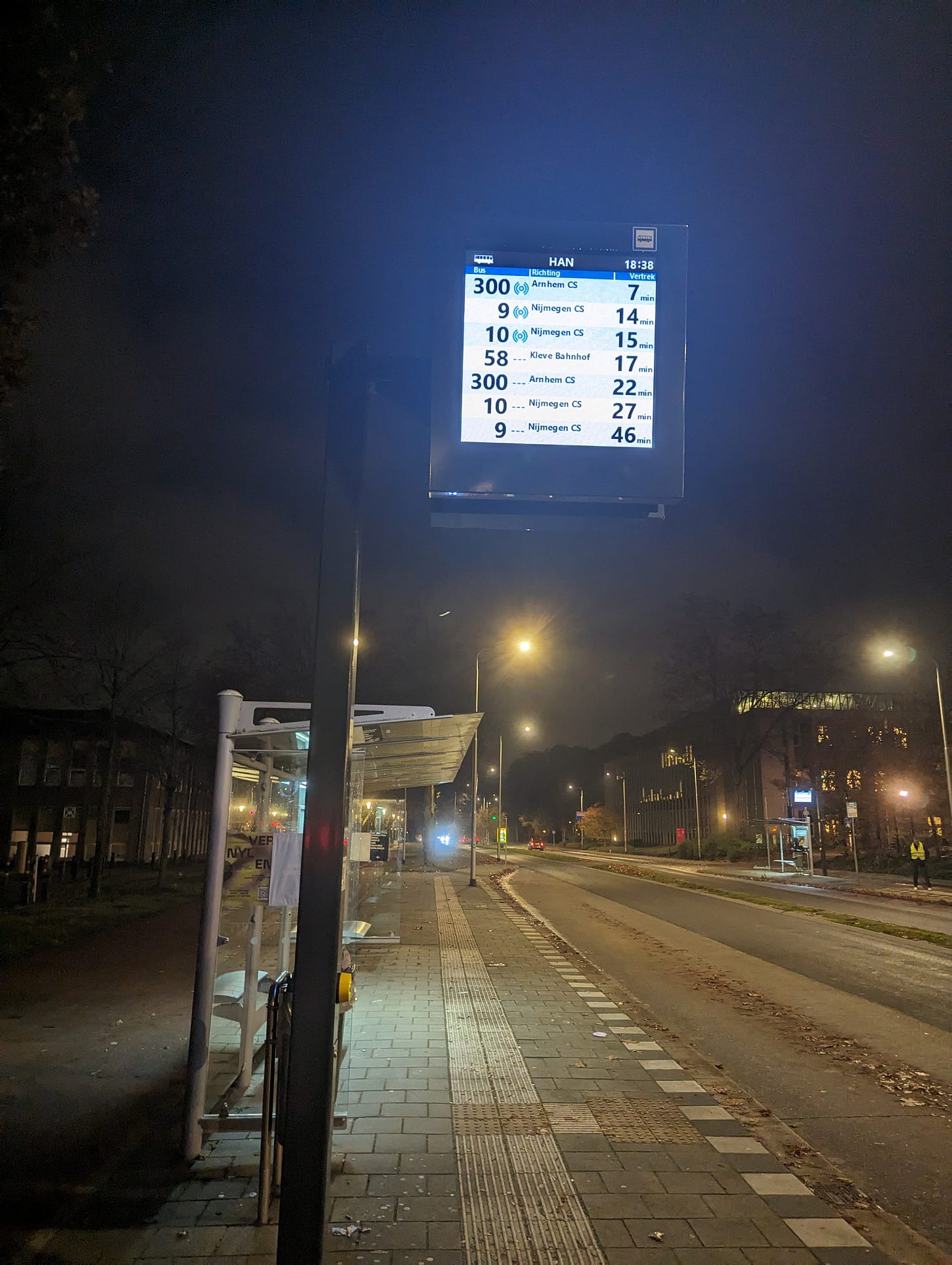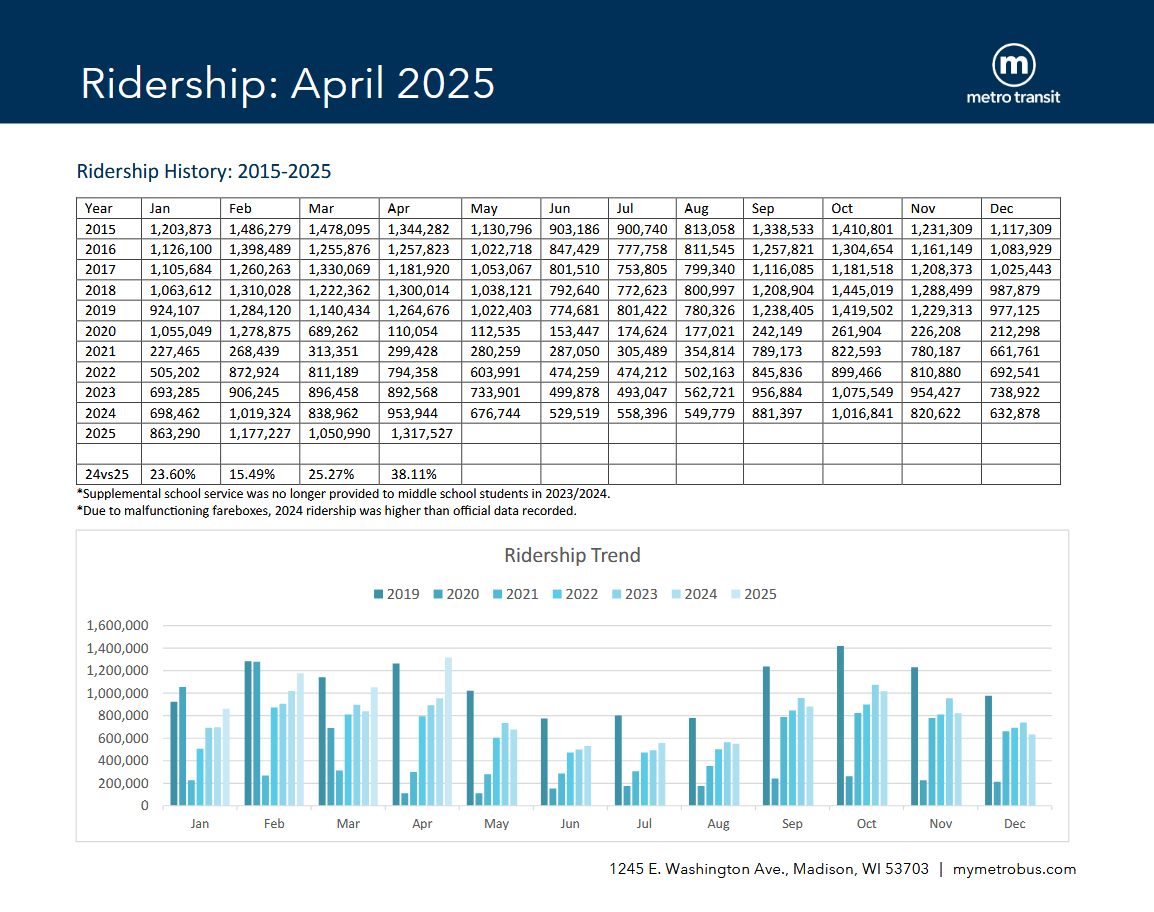BRT Receipts, Milestones, and Aspirations
I'm not above calling it all out
If you didn’t hear, Madison’s bus is back:
Metro Transit is celebrating a major milestone: more than 1.3 million rides were taken in April, marking the highest April ridership in nearly ten years and signaling a powerful comeback for public transit in the region. It was also the highest month of ridership since 2019.
It’s possible you missed it though, someone isn’t the biggest fan of Bus Rapid Transit (BRT) and related changes. We are several weeks after the announcement and the Cap Times still has not articulated the records that were broken. The latest on BRT is an update on the North-South BRT route.
I think it’s important to recognize when you’re wrong about something and to learn from it. It’s entirely possible I’ll be eating my words in a few years and this success we’ve seen from Madison’s Bus Rapid Transit is only transitory. So to offer an olive branch, here are some things I’ve gotten wrong since paying attention to Madison’s local politics:
Being an alder is a thankless job and most alders do care what their constituents think. Being willing to meet with strangers to listen to them patiently as they complain (I complained about Landmarks) is admirable
Bike projects can be expensive (still less expensive than car infrastructure, but even I won’t support spending $42 million on an underpass for John Nolen)
I would like to see BRT opponents to reflect on this ridership data from April:
Specifically the year over year increases showing a minimum 15.49% jump in February and a whopping 38.11% jump in April. Did this exceed opponents expectations? What were they anticipating ridership would look like 6 months after BRT went live?
Why it works for me
In 2023 the network redesign provided my small apartment complex an every 30 minute bus to the Capitol. It was great for getting Downtown, but there are several recorded moments of me stepping away from public comment, rushing to get to the bus so I didn’t have to wait half an hour. For non-transit riders it probably looked like I was crazy, but there really is nothing worse than watching a bus pull away and you start to wonder if the walk will be faster.
I was antsy for 2024. The arrival of Bus Rapid Transit (BRT) meant 15 minute or less headways, dedicated bus lanes in some parts of the City, and faster ways to board and pay. I moved from my Southwest apartment to the Isthmus so I could ditch my car (saving money and letting me read while commuting). The couple of months I had to wait were tolerable, but seeing the stations go up near my apartment had me optimistic. The “bendibois” (the BRT buses are accordion buses) arrived and the system exceeded my expectations.
The process is so smooth. I step on and scan in seconds. It’s at grade, so I can roll on my e-bike. My fare is capped daily to $5 even though I take 4 buses (one transfer each way)1. The real-time map and the Transit App let me track the buses to minimize the amount of time I spend waiting, but I also know that if I miss the bus there’s another one at most 15 minutes away on my commute days.
Most days I see full buses. Even on Saturdays all the way at Hilldale mid-day the A bus has dozens of passengers. My favorite complaint from non-transit users is “the bus is always empty” way out in the suburbs (where density is the lowest and riding the bus is most difficult). If they would take the bus once through the Capitol stops, they would see why it’s so vital to so many2 (or maybe they see it when the bus zooms by on Johnson St.). Being able to move past traffic is a game changer.
There have been hiccups. Just a few weeks ago one of my buses just stopped running. We transferred to a separate bus, and I saw it running 1 minute after we departed, but I’ve also had to deal with “ghost” buses and confused transit boards. I’ve been told by a trusted source a third party that has control over the transit boards. But ghost buses, or buses that appear to be on the map but aren’t actually driving towards you, often lead to being late to my destination.
Can we do better than this?
Yes. Even though I’ve been pleased with the service so far there’s room to improve. There are larger issues and smaller nitpick ones.
Larger Issues
Safety and comfort
Payment ease
Better headways
Smaller Issues
Buses skipping stops
Boarding gaps
Acceleration and grip
Safety and comfort are the clearest issues that Madison Metro will have to contend with to see continued expansion of ridership. Although many apartments are going up in the Transit Oriented Development overlay district, there are still “marginal” bus riders who are not taking BRT. Marginal bus riders are the people who currently commute via private vehicle, but in the right circumstances could be persuaded to take the bus. They can be persuaded to take the bus by driving getting worse (worse traffic, a congestion pricing zone, Madison drivers getting more and more reckless) or by bus improvements. We’ve seen major strides in frequency (the most important factor for riders) and reliability is improving from my own experience.
So far this year multiple bus drivers have been assaulted, including one incident that caused the bus to drive into a building. Being harassed at your job is not something I ever want to experience and it breaks my heart that people do this. I’ve personally witnessed passengers harass drivers because the passenger would not pay their fare. I’ve seen passengers get into physical altercations, leaving me to call out to the bus driver as if they are the authority figure on the vehicle and they should somehow handle the situation (they shouldn’t have to!). I’ve taken the bus a couple hundred times, but this still should happen less often (preferably never!).
Madison Metro is working on solutions that range from reviews to citations for non-fare payment to increased penalties for disorderly conduct towards drivers. The new buses have safety barriers and there’s discussion of retrofitting the older fleet as well. I want our drivers to be protected, but I also want passengers to feel safe as well.
Several of the incidents stemmed from the passenger not paying their fare. I would think fare enforcement would be the best solution. I enjoy reading Darrell Owens and The Discourse Lounge (a blog focusing on housing and transit). He shares the same priority of increasing safety and comfort for public transit, but says that instead of wasting resources on fare enforcement, make transit frequent and reliable (more riders) and have more staff riding transit.
The most important thing American transit systems can do is have visible personnel. If you are in a station alone or with very few people in the middle of nowhere or deep underground, it can be unnerving… This is where transit staff and ambassadors comes in. Special transit staff should roam stations, giving people assistance and resolving conflicts and health crisis issues.
I witnessed this the other day; an instructor for Metro saw a passenger get on board without paying their fare. They talked to them, said they needed to pay, and the passenger complied. The bus didn’t have to stop, the driver wasn’t distracted, and the instructor was able to take a moment to enforce the rules. This was a working system and I think having someone who can watch without having to operate the vehicle is a benefit. I know our Mayor takes the bus3 and I appreciate that she is using the same transportation that we all use. But it’s nice to see other uniformed City Staff, especially those who know the ins and outs of the vehicle being driven, able to act passively as a sense of authority.
I will say, with the Automated Passenger Counting system that’s in place on BRT, I think a worthy metric would be to compare APC counts to fare counts. If we are seeing a large discrepancy between the two, we should either calibrate the APC or work to have everyone contribute payment towards the ride. We have half-price fares ($28/month cap) for low-income residents and I would rather we sign up everyone who is eligible than make the bus free.
For payments, we should make it possible to pay by credit card. This looks like it’s underway. If demand accounts for it, I hope we can reduce headways so frequency is less than 15 minutes (the true BRT standard). My guess is it will take a while to get to enough ridership for more buses, but we could invest in more dedicated bus lanes and signal priority that keeps buses on time and out of traffic.
The smaller issues:
Buses will sometimes skip non-time stations (stations where they have to stop if they are ahead of schedule) if the person isn’t waiting on one of the boarding platforms. In the winter it’s cold, I’m going to be planted under the heat lamp and I still want drivers to stop. We could fix this with “stop indicators” that exist in other countries (see below)
Bus drivers are getting better at determining how close they can drive up to the BRT stations. The closer they are, the easier it is to board passengers with wheels. I hope Madison Metro continues to emphasize close boardings
On rainy and snowy days, the new buses sometimes lose grip. They are also electric, which means acceleration is quick and you can get thrown around pretty aggressively if you are standing and not paying attention. I think this will get better with more experience, but it’s worth noting

I think if we see improvements on these issues, Madison could become a serious transit city. The bus does it’s job well and traffic volumes are down on E Washington since 2023. Drivers benefit from the marginal rider hopping on the bus. I hope they will come around to supporting efforts to make transit better so they don’t have to deal with as much traffic.
My commuter pass caps me at $65 anyway and I use it most months.
Over 1 million rides in April!
It shocks me that no one recognizes the Mayor. One of us, one of us…



